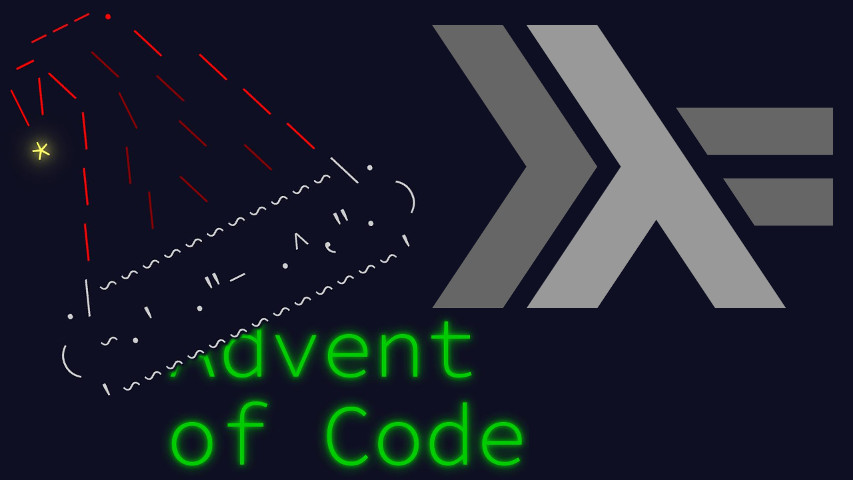Today’s Advent of Code puzzle, “Distress Signal”, is one of those classic define-a-bespoke-ordering-on-a-data-structure problems.
We’ll tackle it by writing as little code as possble, which translates to a largeish import list. Reproduced right from the start, as this is literate Haskell.
import Control.Applicative ((<|>),liftA2)
import Data.Aeson (FromJSON,eitherDecodeStrict',parseJSON,withArray,withScientific)
import Data.List (findIndices,sort)
import Data.Foldable (toList)
import Data.Functor ((<&>))
import Data.Scientific (floatingOrInteger)
import qualified Data.ByteString.Char8 as BSA packet is either an integer or a list of recursive packets.1
data Packet = I Int | L [Packet]A packet as given in the puzzle input happens to be valid JSON, so let’s parse it from there and spare futile head-scratching.
instance FromJSON Packet where
parseJSON = liftA2 (<|>) parseInt parseList
where
parseInt = withScientific "integer" $
floatingOrInteger >>>
either (const (fail "Not an integer")) pure >>>
fmap I
parseList = withArray "list" $
toList >>>
traverse parseJSON >>>
fmap LTo parse globally, I’ll assume the input is well-formed and ignore the explicit pairings by skipping blank lines and deferring the re-pairing to part 1 which is the only one to make use of it.
main :: IO ()
main = do
Right packets <-
BS.getContents <&>
BS.lines >>>
filter (not . BS.null) >>>
traverse eitherDecodeStrict'
print (part1 packets)
print (part2 packets)Now the puzzle revolves entirely around being able to sort packets.
Comparing two integer values is straightforward, I’ll delegate it to
the underlying Ints:
comparePackets :: Packet -> Packet -> Ordering
comparePackets (I a) (I b) = compare a bComparing two list values follows the same lexicographical ordering
rules as standard Haskell lists, provided their elements have a proper
ordering. Which is not the case for us here yet, as there’s no
Ord instance on Packets. But assuming we could
define one, we could delegate all the same:
comparePackets (L as) (L bs) = compare as bsLast, comparing an integer to a list works as if promoting the integer to a single-element list.
comparePackets a@I{} l = comparePackets (L [a]) l
comparePackets l b@I{} = comparePackets l (L [b])So we need to define an Ord instance on
Packets. How would we do that? Well, all we need to do is
call our comparePackets function!
instance Eq Packet where (==) = ((== EQ) .) . comparePackets
instance Ord Packet where compare = comparePacketsIt’s worth pondering why we needed both an Ord instance
and an external comparison function. The reason is that sneaky
Eq instance above. It’s needed to declare an
Ord instance. And though what I’ll be doing probably
doesn’t need to call it, I don’t want to be liable for breakage when
that changes later on.2
In part 1, we’re only looking to identify the correctly ordered pairs.
part1,part2 :: [Packet] -> Int
part1 = sum . map succ . findIndices (uncurry (<)) . pairsIn part 2, we’re looking for the sorted positions of two special markers called “dividers”.
part2 = let dividers = [L[L[I 2]],L[L[I 6]]] in
product . map succ . findIndices (`elem` dividers) . sort . (dividers ++)And that’s all there is to it!
Well, except for a little bit of boring support code.3
pairs :: [a] -> [(a,a)]
pairs (a:b:xs) = (a,b) : pairs xs
pairs [] = []
(>>>) :: (a -> b) -> (b -> c) -> a -> c
(>>>) = flip (.)
infixr 2 >>>This concludes today’s solution. See you tomorrow!
If you’ve read the problem, you’ll know this is factually wrong: a packet there is necessarily a list. My extension doesn’t result in further inconsistency down the road, so I’ll go with it as it gives the datastructure better regularity, with no need to single out a separate “value” type.↩︎
And while we explicitly only call
(<)in part 1, thesortfunction we use in part 2 is much more opaque and liable to freedom.↩︎(>>>)is already present in the standard library, but with a fixity that’s not perfect for our use here. And it’s shorter to redefine it than to import it altering fixity, so…↩︎



